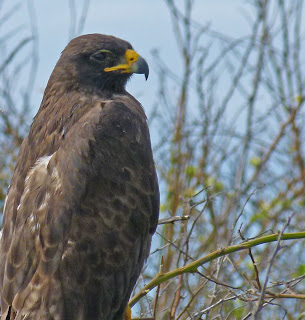As a dedicated raptorphile, I kept an eye on the sky for the Galapagos Hawk, top of the food chain and endemic to the islands. Two other raptors, the Short-eared Owl and Common Barn Owl, can also be found but only at night, when I was sound asleep in our cabin. I read stories of these hawks landing on people's heads, but had no such luck myself! In a celebrated incident, Darwin found he could push a wild hawk off a tree with the barrel of his gun.
There are only about 150 "pairs" which practice "cooperative polyandry," whereby the alpha female mates with up to four males which all then help her raise up to three chicks. They breed in arid areas and within volcanic calderas, but range across the islands. With no trees, a rock makes a handy perch. These hawks hunt anything from iguanas and snakes to rats and birds. They are also the major scavengers of the islands, feeding on any rotting carcass - their favorite is goat. There is nothing like a vulture on the island, so these hawks step into the empty niche.
As we gathered for coffee and breakfast just off Santa Fe Island, we saw a large dark shape fly into the cacti. Feathers blowing in the wind, it perched on the opunti for a while looking around for its own breakfast.
Spying something on the ground, it hopped down on the rocks, and quickly disappeared from our sight.
On Espanola Island, we stood on the cliffs watching Winged Albatross, Blue-footed Boobies, Nazca Boobies, Frigate Birds and Swallowtail Gulls soaring through the salt spray. But one bird had an entirely different profile. Rather than long slender wings, this bird had the broad rounded wings of a hawk. Sure enough, it was our Galapagos Hawk, easily identifiable among the sea birds.
This raptor is found throughout the archipelago, with the exception of San Cristobal, Floreana and Santa Cruz, where people have hunted it out, and Genovesa, where the Short-eared owl is the dominant predator.






1 comment:
Gorgeous...of course it is Gorgeous!!!
Post a Comment